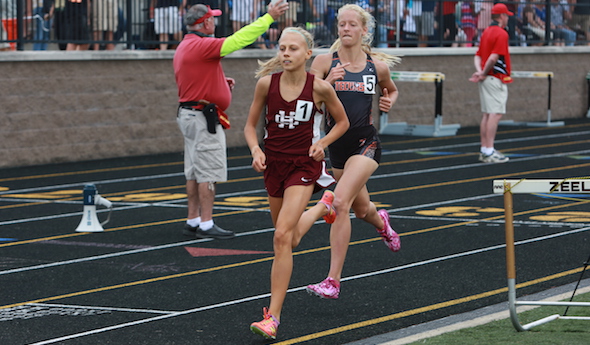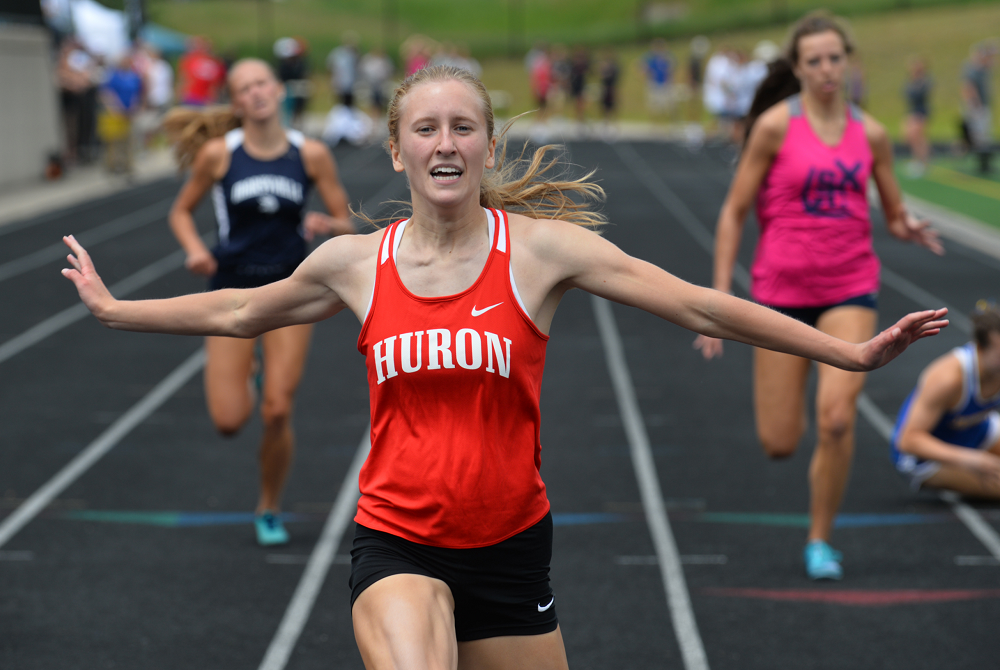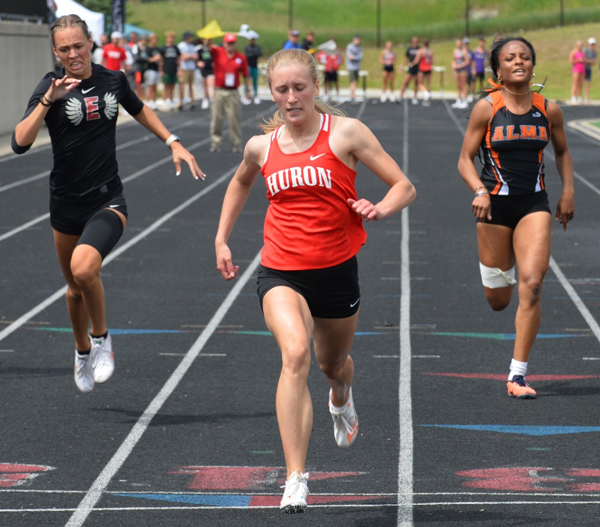
Inspiration Fuels Windemuller's Pursuit
By
Tom Markowski
Special for Second Half
June 3, 2017
ZEELAND – It hasn’t been easy at Holland Christian this school year. Certainly not as easy as Kayla Windemuller made it look on the track Saturday.
Windemuller pulled off a rare triple as the junior defended her titles in the 1,600 and 3,200-meter runs and ran anchor on the winning 3,200 relay (9:09.41) at the Lower Peninsula Division 2 Track & Field Finals at Zeeland.
Five people associated with Holland Christian schools died this school year. One was a 13-year-old girl and two were teachers, and it’s something Windemuller and everyone associated with the schools can’t forget.
“It’s tough at the school,” Windemuller said. “In some meets during the season it’s tough to run. When I run in those I think of them. They inspire me. I run for them.”
Windemuller is an inspiration to any young runner, distance or otherwise. She set a personal record in the mile (4:52.60) and, although she came up short of her goal in the 3,200 run (10:49.90), it was a day to savor.
“I was concerned about the heat, but it didn’t affect me too much,” she said. “It’s amazing to defend my title(s). I really like (running) the two mile. I’m more of a distance girl.
‘My goal was to get under 10:40. At the start I felt pretty good. That’s OK. I ran a PR in the mile. It is a long day, but it’s nice to have the meet spaced out. We run the relay in the morning, and then the races get slower as the day goes on. The day, overall, was awesome. I’m not happy with the times. The three state titles are sweet.”
Team title No. 2
Lansing Waverly competed well but luck also played a part in its second consecutive title.
Waverly had no individual winners, but did place first in two relays (400 and 800) to win with 47 points. Zeeland East was second with 46, and Holland Christian was third with 34.
Here’s how some of the drama played out.
Due to injuries Waverly coach Rex Wilkes, Jr., had to shuffle his lineup on the relays. The Warriors had the fastest time in the division in the 1,600 relay entering the Finals, but Wilkes made the decision not to compete in the event while attempting to save his top runners for other races.
It worked, but just barely.
“I knew we could score around 50 (points),” he said. “I just didn’t know what the other teams would do. We got some extra points in the shot. We got 10 there. And then I was told that Priscilla (Trainor) had to finish third or higher in the 200 for us to win.”
Trainor finished third. That’s not all. Suenomi Norinh of Zeeland East finished tied for first in the 100 hurdles with times measured out to hundredths of a second; to break the tie, it was determined she finished second by two thousandths of a second.
“Sometimes it’s good to be great,” Wilkes said. “Sometimes it’s good to be lucky.”
Norinh, a junior, did take first in the high jump (5-foot-8) and was second in the long jump.
Double winner
Liz Pyles of Cadillac placed third in both the discus and shot put last season as a junior, and she took that experience to place first in the shot with a put of 45 feet, 4 inches, a personal best, and won the discus with a throw of 146-3.
“I’m so happy,” she said. “I had three new PRs today (in the shot put). I’m so pleased.
“Last year was something to build upon. I worked with my coach. I worked in the weight room. I went to a bunch of camps. I’m real serious about this.”
Pyles signed with Grand Valley State University and expects to compete in both events. She qualified for the MHSAA Finals in the shot put all four seasons and the discus three times. Even so, she doesn’t have a favorite.
“It depends on the season,” she said.
Catching up quickly
Zoe Eby of Carleton Airport is a notorious slow starter. And when you’re competing in the 100 dash, that usually doesn’t bode well.
Eby got off to a poor start again but managed to come back to win the race with a time of 12.11.
“The last 30 meters was really close,” she said. “When I got off to that start I thought I would (finish) in the middle of the pack. I honestly don’t know how I did it.”
Eby, a junior, also defended her title in the 200. As a freshman she won the 400. She doesn’t compete in that event anymore.
“It’s not my niche,” she said.
Switching gears
Jakarri Alven of Grand Rapids Catholic Central wasn’t at her best Saturday. She said she had to pull out of the 200 because she was feeling ill.
Nevertheless, she won the 400 (56.48), a race she also won last year as a freshman, and she ran anchor on the winning 1,600 relay.
“I’m better at the longer distances,” she said. “But I like the (200). I got off to a good start today (in the 400). It’s the longer distances that I can work through better. I guess I’m better at it.”
Waiting pays off
Waiting for the other competitors to complete their jumps in the long jump was getting to Taylor Dziatczak of Macomb Lutheran North. Dziatczak had used up her tries and stood in first place with a jump of 17 feet, 11½ inches.
“It was a nail-biter,” she said. “A couple of girls who were close had a couple more jumps left. The girl from Zeeland East (Norinh) had three more left. I had to go to some deep breathing to stay calm.”
Dziatczak, who placed second last year, did hold on for first.
The long jump isn’t her best event, and it’s really not second as far as favorites. The javelin is tops with her. Dziatczak is a two-time AAU All-American in the javelin and has signed with Ashland University in Ohio to compete in the heptathlon. That’s seven events, in case you’re wondering. She placed in the javelin as a sophomore nationally in her age group and was third this year. Dziatczak, who is 17 years old, pointed out she moved up to the 18-and-under age group this year.
She just started competing in the heptathlon two years ago.
Her second favorite event is the 200 dash. The other events are the 100 hurdles, 800 run, high jump and shot put.
“I ran. I jumped. I figured why not do all of the others?” she said.
Why not indeed.
Record vaulter
Spring Lake senior Gabriella LeRoux set the only meet record in Lower Peninsula Division 2 for this season, pole vaulting 12 feet, 6 inches to break Kristen Hixson's mark of 12-4 set in 2010 while competing for Remus Chippewa Hills.
LeRoux's best this season heading into the meet was 12-0. A junior, she also won the pole vault championship in 2016 and was second in 2015 to her older sister Allie.
PHOTO: Holland Christian's Kayla Windemuller stays a pace ahead of Tecumseh's Christina Sawyer during one of their two races against each other Saturday. (Photo by Janina Pollatz/RunMichigan.com.)

Multi-Sprint Champ Racing to Finish Huron Career Ahead of the Rest Again
By
Keith Dunlap
Special for MHSAA.com
May 25, 2023
NEW BOSTON – If there was one thing Elizabeth Anderson took pride in elementary school, it was simply showing that she could outrun everyone in sight.
 In fact, Anderson has an explanation for all the success she had in those playground races.
In fact, Anderson has an explanation for all the success she had in those playground races.
“Dominance when you are in elementary school,” Anderson quipped. “I don’t think I ever had a nickname. I just think everyone knew I was fast.”
Years later, pretty much everyone who follows track & field in the state of Michigan can attest to that.
A senior for New Boston Huron, Anderson has been faster than most other competitors in the state during her three-year high school career (with her freshman season in 2020 canceled due to COVID-19).
Last year, Anderson won titles at the Lower Peninsula Division 2 Finals in the 200-meter (25.07) and 400-meter (56.28) dashes, and was runner-up in the 100-meter dash (12.23).
Often, top sprinters focus on one or two of those three races. But Anderson is certainly a different breed of sprinter because she does all three.
In fact, she holds school records in all three of those events, and if all that weren’t enough, Anderson is a part of all three sprint relay teams.
“It is hard to give her events off,” said New Boston Huron head girls track coach Danielle Lobato.
Despite the different styles the 100, 200 and 400-meter dashes present, Anderson said there usually isn’t much adjusting when she goes from one of those races to another.
 The strategy is simply, “Let’s beat the other girls to the finish line.”
The strategy is simply, “Let’s beat the other girls to the finish line.”
“I don’t really go into each race changing up how I would run,” she said.
While enjoying and succeeding in all three races, Anderson said she actually does have a favorite among them.
“I would say the 400 is probably my favorite,” she said. “Even though it hurts, it’s satisfying to see how much you can get your time down in the 400 compared to any other race.”
Anderson said she started running track in sixth grade, but really got serious about it during the summer after her sophomore season, when she was invited to run for a local club.
Eventually, that led to her competing over the winter in indoor events.
She lived and breathed track so much that last fall, she decided to not run cross country so she could focus on a weightlifting regimen aimed at developing more leg strength.
“Once I started doing summer track, I realized I wanted to be doing this all the time,” she said.
Lobato said oftentimes in practice, Anderson is a de facto coach, given there is no better person she can think of for the younger runners on the team to learn from.
“I can’t always demonstrate these things I’m trying to teach,” she said. “You get to see it in real life (from Anderson), not in a YouTube video.”
After winning the 100, 200 and 400-meter dashes at her Regional meet last week, Anderson has her sights set on achieving the same trifecta of titles at next Saturday’s Finals in Grand Rapids.
Anderson has signed to run track at Michigan State, but has been plenty motivated to keep producing this spring in her final high school season.
“I’m really looking to defend my titles,” she said. “That is what is really motivating me to keep going. I want to keep in shape for the college season. I don’t want to lose any of the progress I have made. Ultimately, I just love running track.”
And since elementary school, Anderson has loved — and succeeded in — outrunning everyone else to the finish line.
“We knew we were getting something special,” Lobato said of when Anderson arrived in high school. “But you never expect this. All that she has accomplished is amazing.”
 Keith Dunlap has served in Detroit-area sports media for more than two decades, including as a sportswriter at the Oakland Press from 2001-16 primarily covering high school sports but also college and professional teams. His bylines also have appeared in USA Today, the Washington Post, the Detroit Free Press, the Houston Chronicle and the Boston Globe. He served as the administrator for the Oakland Activities Association’s website from 2017-2020. Contact him at [email protected] with story ideas for Oakland, Macomb and Wayne counties
Keith Dunlap has served in Detroit-area sports media for more than two decades, including as a sportswriter at the Oakland Press from 2001-16 primarily covering high school sports but also college and professional teams. His bylines also have appeared in USA Today, the Washington Post, the Detroit Free Press, the Houston Chronicle and the Boston Globe. He served as the administrator for the Oakland Activities Association’s website from 2017-2020. Contact him at [email protected] with story ideas for Oakland, Macomb and Wayne counties
PHOTOS (Top) New Boston Huron's Elizabeth Anderson clears the finish line during last season's LPD2 400 race. (Middle) Anderson, middle, outpaces the field to also win the 200. (Click for more from RunMichigan.com.)

